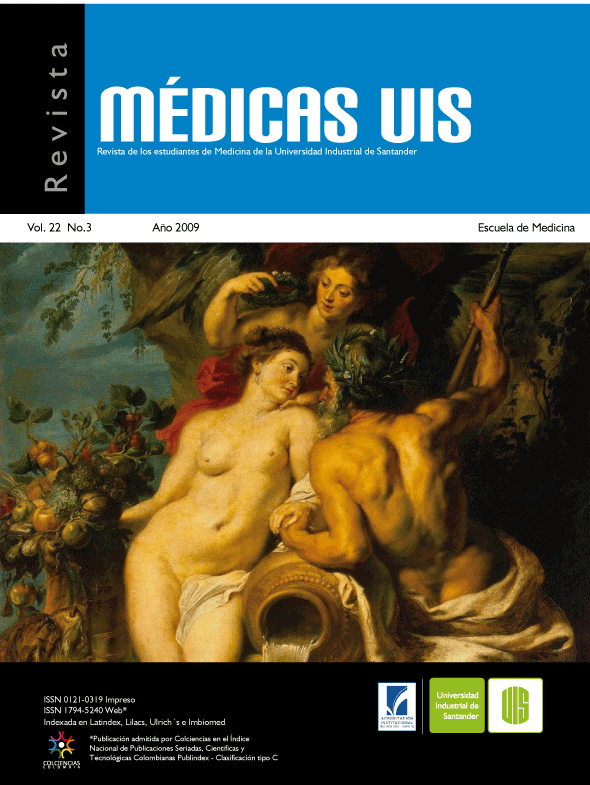Abstract
Genus salmonella includes enterobacteriaes responsible of a great amount of infectious diseases. Focal complications are not frecuent. We conducted a 5 retrospective study between 1996 and 2002. We included 153 cases with salmonella infection, 13 of which (8, 5%) with ages between 17 and 80 years (median 37) presented focal complications. Nine of the patients were male (69%) and in 7 cases (54%) risk factors were present, 12 (93%) presented previously gastroenteric signs. Microbiological diagnosis established through stool examination (5 cases), in 6 (46%) with blood culture, in other 3 cases, both were positive. Complications included splenic abscess, pneumonía, endocarditis, endarteritis, sepsis, hepatitis and reactive arthritis. No clear seasonal pattern was established. Eight patients (64%) received ciprofoxacin. Three patients were surgically treated. Two patients died. Conclusión: In our series prevalence and morbimortality in focal complications are high. The most common presentation was sepsis (4 cases), pneumonía (3) and splenic abscess (2). Bacteraemia was documented in a high percentage of cases. No seasonal pattern was established.
Key words: Salmonella. Salmonella infections. Nontyphoidal salmonella. Salmonella Typhi.
References
2.Garthright WE, Archer DL, Kvenberg JE. Estimates of incidente and costs of intestinal infectious diseases in the United States. Public Health Rep 1988;103:107-15
3.Surveillance for foodborne disease outbreaks - United States, 2006. MMWR Morb Mortal Wkly Rep 2009;58:609-15.
4.Rubino JR. The Economic impact of human salmonella infection Clinical Microbiological Newsletter 1997;19:25-32.
5.WHO/CDS/CSR/EPH/2002.21 Global surveillance of foodborne disease: Developing a strategy and its interaction with risk analysis. Report of a World Health Organization consultation Geneva, Switzerland 26-29 November 2001.
6.Seligmann E, Saphra I, Wassermann N. Salmonella infections in man: análisis of 1000 cases bacteriologically identified by the New Cork salmonell Center. Am J Hyg 1943;38:226-49.
7.Ispahán P, Snack RCB. Enteric fever and other extraintestinal salmonellosis in University Hospital Nottingham, UK between 1980 and 1997. Eur J Clin Microbiol Infect Dis 2000;19:679-87.
8.Allos BM, Moore MR, Griffin PM, Tauxe RV. Surveillance for sporadic Foodborne disease in the 21st century: the food Net perspectiva CID 2004;38(Suppl 3): S115-S20
9.Voetsch A, Van Gilder TJ, Angulo FJ, Farley MM, Shallow S, Marcus R, et al. Food Net estimate of the burden of iones caused by nontyphoidal salmonella infections in the United States. CID 2004; 38(Suppl 3): S127-34
10.Comentario epidemiológico de las Enfermedades de Declaración Obligatoria y Sistema de Información Microbiológica, España. Bol Epidemiol Sem 2001;6:49
11.Suárez Alfonso MC, Mantilla Anaya JR. Presencia de Salmonella serovariedad Enteritidis en productos de origen avícola y su repercusión en salud pública. Iatreia 2000;13:237-45.
12.Organización panamericana de la salud. Informe Anual regional de los Paises participantes en la red de monitoreo/vigilancia de la resistencia a los antibióticos 2002.(en linea) (última consulta 1 diciembre de 2006). Disponible en: http://www.ops-oms.org/spanish/AD/DPC/CD/amr-santa-cruz-col.pdf.
13.Millar SI, Pegues DA. Salmonella Species, incluiding Salmonella typhi. Mandell GL, Bennet JE, Dolin R editors. Principles and practice of infectious diseases (5th ed.) Churchill Livingstone, 2000; p 2344-56.
14.Kenedy M, Villar R, Vugia DJ, Rabatsky-Her T, Farley MM, Pass M et al. Hospitalizations and deaths due to salmonella infections, Food Net, 1996-1999. CID 2004;38(Suppl 3): S142-8.
15.Gomez Garcés JL, Ales JM, Soriano F, Gaspar MC, Fernandez Clua MA. Formas focales y septicémicas de las salmonelosis. Rev Clin Esp 1980;156:337-40.
16.Canut Blasco A , Brezmes Valdivieso F, Antolin Ayala MI, Yagüe Muñoz A, Arribas Jiménez A. Infecciones focales por salmonella no Typhi: revisión de nuestra casuística y comparación con otras series.Rev Clin Esp 1992;191:71-5.
17.Brasseur Ph, Humbert G, Morel A, Lemeland JF. Les salmonelloses non tphoïdiques. Étude clinique de 491 cas. Sem Hôp Paris 1982;58:915-20.
18.Brown M, Eykyn SJ. Non-Typhoidal salmonella bacteriaemia without gastroenteritis: a marker of underlying immunosuppresion. Review of cases at St. Thomas ́Hospital 1970-1999. J Infect 2000; 41, 256-9.
19.Rodriguez M, de Diego I, Martinez N, Rodicio RM, Mendoza CM. Nontyphoidal Salmonella causing focal infections in patients admitted at a Spanish general hospital during an 11-year period (1991-2001).Int J Med Microbiol 2006;296:211-22.
20.Threlfall EJ. Antimicrobial drug resistance in salmonella: problems
